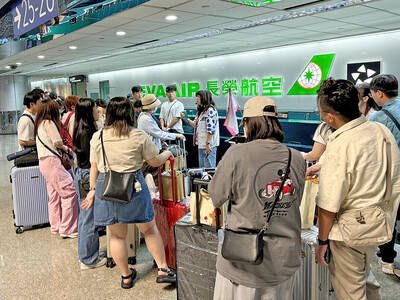China’s military capability represents a substantive threat to national security as it constitutes a challenge to the existence of a median line in the Taiwan Strait, the Ministry of National Defense said in a report to the Legislative Yuan yesterday.
The drills staged in waters around Taiwan last month by the Chinese People’s Liberation Army (PLA) enabled it to test its game plan for invading Taiwan and breaching the first island chain while strengthening its area denial capability, the ministry said in the latest annual report on China’s military power.
The PLA has put its second domestically made aircraft carrier, Fujian, to sea this year, which also saw China’s continued deployment of other advanced systems including J-16 fighter jets, J-20 stealth jets and transport aircraft, it said.

Photo courtesy of Military News Agency
The debut of new weapons is intended to showcase the fruits of Chinese President Xi Jinping’s (習近平) military reforms and lay the foundation for his election for a third term at the 20th National Congress of the Chinese Communist Party next month, it said.
Assessing the international situation, the report said that the Russia-Ukraine conflict could prompt Beijing to re-examine its war plans, especially in light of the political and economic sanctions against Moscow, it said.
Moscow’s use of nuclear threats to deter a direct intervention from NATO and Ukraine’s ability to strike at Russian supply lines would likewise be of interest to the Chinese military, it said.
Developments in the PLA’s hardware, its pattern of military exercises, and its doctrine of fighting short, decisive and low-casualty wars have led the ministry to deduce the range of possible military actions China might use against Taiwan, it said.
The actions span from an air-sea blockade, seizing Taiwan’s outlying islands, decapitation strikes and all-out invasion to gray zone conflicts, cognitive warfare and further attempts at intimidation via war drills, it said.
China must be able to deliver an amphibious force to the shores of Taiwan proper by sea and air to achieve an invasion’s strategic objective, which is the occupation of territory, it said.
Therefore, the PLA is likely to treat the rapid seizure of air, sea and electronic warfare superiority as the key to victory, but a lack of amphibious vessels and logistics continues to limit its ability to carry out large-scale ambitious operations, the ministry said.
The report for the first time included a chapter on nonmilitary activities targeting Taiwan, including joint exercises of maritime forces, navy and coast guard units, and the utilization of fishing boats and scientific vessels to provide cover for military patrols.
Additionally, China has deployed civilian aircraft, drones and weather balloons near Taiwan proper and its outlying islands in a bid to harass the country, conduct surveillance and bait the Taiwanese military to test its response, it said.
The actions the PLA carried out in Taiwan’s periphery — including the large-scale joint exercises — were part of an effort to test its invasion plan and see whether Chinese forces possess the capability to implement it, the ministry said.
Furthermore, the Chinese military has adjusted the deployment of its forces in air bases opposite to Taiwan, conducted targeted intelligence gathering operations, and made use of the drills as material to intensify its campaign of cognitive warfare against Taiwan, it said.

An alleged US government plan to encourage Taiwan Semiconductor Manufacturing Co (TSMC) to form a joint venture with Intel to boost US chipmaking would place the Taiwanese foundry giant in a more disadvantageous position than proposed tariffs on imported chips, a semiconductor expert said yesterday. If TSMC forms a joint venture with its US rival, it faces the risk of technology outflow, said Liu Pei-chen (劉佩真), a researcher at the Taiwan Industry Economics Database of the Taiwan Institute of Economic Research. A report by international financial services firm Baird said that Asia semiconductor supply chain talks suggest that the US government would

Starlux Airlines on Tuesday announced it is to launch new direct flights from Taiwan Taoyuan International Airport to Ontario, California, on June 2. The carrier said it plans to deploy the new-generation Airbus A350 on the Taipei-Ontario route. The Airbus A350 features a total of 306 seats, including four in first class, 26 in business class, 36 in premium economy and 240 in economy. According to Starlux’s initial schedule, four flights would run between Taoyuan and Ontario per week: Monday, Wednesday, Friday and Saturday. Flights are to depart from Taoyuan at 8:05pm and arrive in California at 5:05pm (local time), while return flights

WANG RELEASED: A police investigation showed that an organized crime group allegedly taught their clients how to pretend to be sick during medical exams Actor Darren Wang (王大陸) and 11 others were released on bail yesterday, after being questioned for allegedly dodging compulsory military service or forging documents to help others avoid serving. Wang, 33, was catapulted into stardom for his role in the coming-of-age film Our Times (我的少女時代). Lately, he has been focusing on developing his entertainment career in China. The New Taipei District Prosecutors’ Office last month began investigating an organized crime group that is allegedly helping men dodge compulsory military service using falsified documents. Police in New Taipei City Yonghe Precinct at the end of last month arrested the main suspect,

Nearly 800 Indian tourists are to arrive this week on an incentive tour organized by Indian company Asian Painted Ltd, making it the largest tour group from the South Asian nation to visit since the COVID-19 pandemic. The travelers are scheduled to arrive in six batches from Sunday to Feb. 25 for five-day tours, the Tourism Administration said yesterday. The tour would take the travelers, most of whom are visiting Taiwan for the first time, to several tourist sites in Taipei and Yilan County, including tea houses in Taipei’s Maokong (貓空), Dadaocheng (大稻埕) and Ximending (西門町) areas. They would also visit